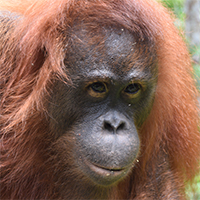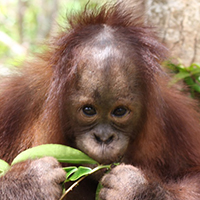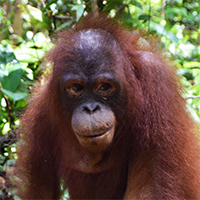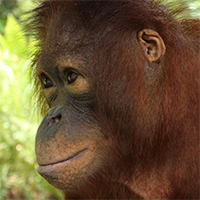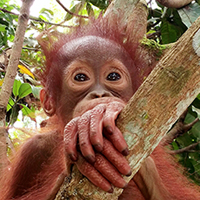At the Orangutan Care Center and Quarantine (OCCQ) in Central Indonesian Borneo, OFI (Orangutan Foundation International) staff provide milk for the older orangutans in OFI’s care. Caregiver Ibu Tuti always looks forward to her encounters with orangutan Robina or “cantik (beautiful) Robina” as she calls her. Indeed a beauty, Robina’s light ginger locks are long… Continue reading Orangutan of the Month for August, 2018: Robina
Tag: Orangutan of the Month
Orangutan of the Month for July, 2018: Kuba
Everybody remembers their first house. Dreams are cast, plans are made and pennies are gathered until the jubilant day the homeowner wakes up in their new bed. Given that orangutans share so much in common with humans, they may look on their first nest with a similar sense of pride. One infant orangutan in OFI’s… Continue reading Orangutan of the Month for July, 2018: Kuba
Orangutan of the Month for June, 2018: Allisson
All orangutans have their own needs and learning styles. At the Orangutan Care Center and Quarantine (OCCQ) in Central Indonesian Borneo, the OFI staff respect the unique personalities of each orangutan. Allisson is a focused and methodical orangutan, and one who does not like to be rushed. Allisson arrived at the Care Center when she… Continue reading Orangutan of the Month for June, 2018: Allisson
Orangutan of the Month for April 2018: Santa Claus
Christmas time is the most wonderful time of the year, or so the song goes. This time of traditions, gift giving, and cheer is also the time we get to spend with family and loved ones. It was during this time a few years ago that a tiny young orangutan orphan arrived to the Orangutan… Continue reading Orangutan of the Month for April 2018: Santa Claus
Orangutan of the Month for Feb, 2018: Jalin
There are currently over 300 orangutans at the OFI Care Center, and no two are the same. It’s never easy selecting one “Orangutan of the Month” but at certain times one individual will stand out. For her great courage and resilience, Jalin has earned the spotlight this month. Jalin arrived at Orangutan Foundation International’s (OFI)… Continue reading Orangutan of the Month for Feb, 2018: Jalin
Orangutan of the Month for Jan, 2018: Ariel
On a warm morning in Central Indonesian Borneo, the caregivers of Orangutan Foundation International (OFI) prepare to escort the orangutans from Pondok Satu into the Learning Forest at the Orangutan Care Center and Quarantine (OCCQ). Pondok (which means “shelter”) Satu is currently managed by an all-female team who care for both female and male orangutans,… Continue reading Orangutan of the Month for Jan, 2018: Ariel
Orangutan of the Month for Dec, 2017: Otan
On a hot afternoon during the rainy season, a vehicle slowly pulled up in the driveway of OFI’s Orangutan Care Center and Quarantine (OCCQ) in Central Indonesian Borneo. The van was soon recognized to be a patrol vehicle of the Sampit Wildlife Department of Indonesia. An officer opened up the car to reveal two little… Continue reading Orangutan of the Month for Dec, 2017: Otan
Orangutan of the Month for Nov, 2017: Andrena
Andrena’s appearance and personality captivate. At first sight, her long, plentiful hair gives the illusion that she is twice the size of her peers at OFI’s Orangutan Care Center and Quarantine (OCCQ) in Central Indonesian Borneo. Her richly-coloured hair seems to flow in all directions, accentuating a certain wild essence in her personality. There is… Continue reading Orangutan of the Month for Nov, 2017: Andrena
Orangutan of the Month for Oct, 2017: Voyce
For orangutan infant orphan “Voyce”, OFI’s Care Center and Quarantine (OCCQ) in Central Borneo was a light that brightened his once uncertain future. Voyce had developed a serious parasitic worm infection that caused gastrointestinal distention. He had a large, visible swelling of the abdomen. While some parasites develop and live within their host unnoticed, the… Continue reading Orangutan of the Month for Oct, 2017: Voyce
Orangutan of the Month for Sept, 2017: Karaba
Karaba is a unique orangutan with her own distinctive expressions and mannerisms. Orangutan facial expressions give hints as to their emotions at a given time. For example, playful infants will sometimes stretch open their mouths, almost like a yawn, just before playing a trick on a staff member or another orangutan. When Karaba drops her… Continue reading Orangutan of the Month for Sept, 2017: Karaba

